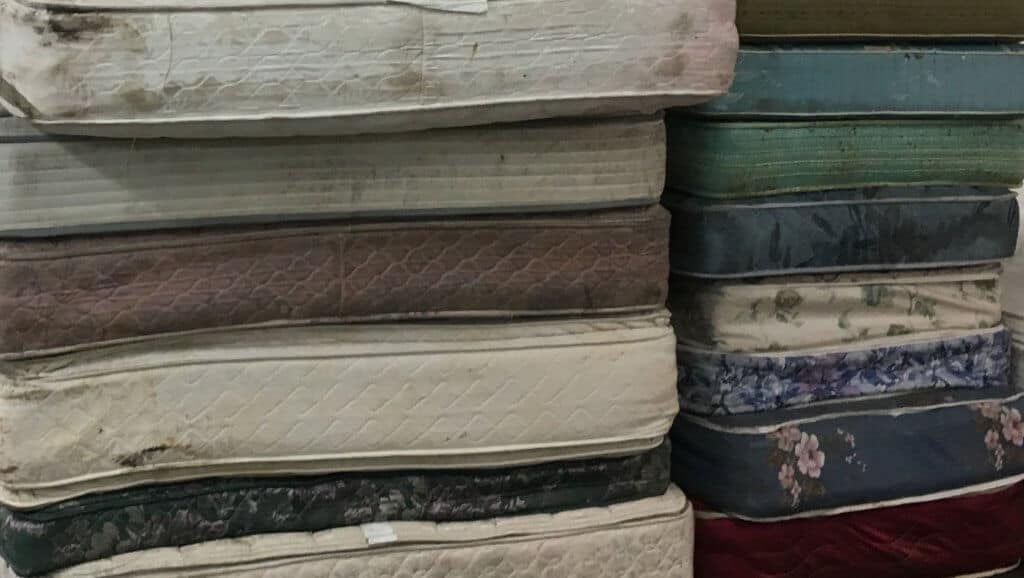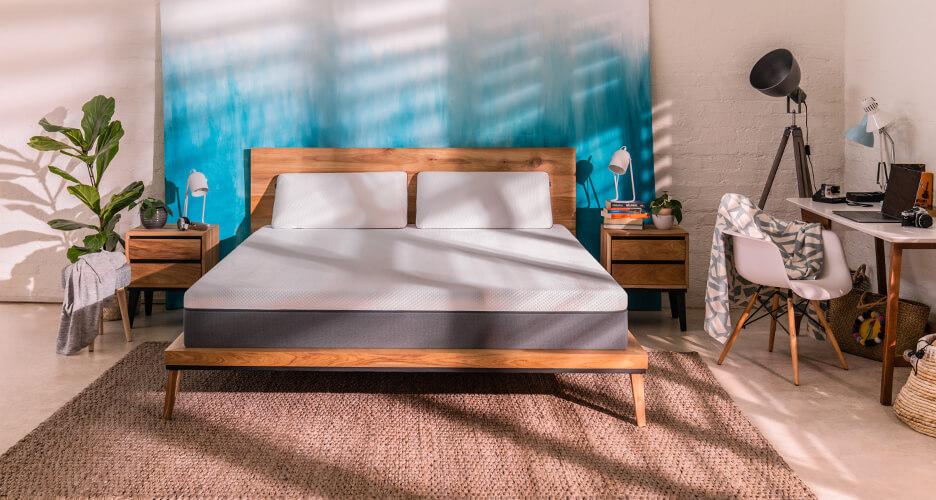It’s the year 2021 and going green means leading a lifestyle that is not just more beneficial for the environment, but also better for us.
We spend a third of our lives sleeping on our mattresses, and look for a high level of comfort and support. But how if during our slumber, we are in fact, absorbing and breathing toxic chemicals?
The chemicals used in the manufacture of most conventional mattresses continue to off-gas, releasing harmful toxins into the surrounding air, filling your bedroom!
Let’s first take a look at some of the chemicals used in conventional mattresses.
Chemical Flame Retardants

Did you know that for each mattress to be sold, it has to pass each country’s flame retardant standards? All UK beds must have a fire-retardant layer or component whether it is within the foam mix or sprayed on afterwards.
Organic materials such as cotton and wool can be used as natural flame retardants, but because they are more expensive to manufacture and produce, Antimony, Boric Acid and Halogenated Flame Retardants (HFRs) are more commonly used.
Antimony is a toxic heavy metal that can cause eye, heart and lung complications. Boric acid, also known as Borate Powder, has been linked to eye and respiratory irritation.
Halogenated Flame Retardants, or HFRs, have been known to delay puberty, reproductive development, causing neurobehavioural changes and even cancer.
These chemicals continue to off-gas over time into the air, dust particles and our skin, getting breathed in by anyone in close proximity and can even be digested.
The US and some of Europe have banned some of these flame retardants. Large international retailers such as Ikea, Macy’s and Walmart have insisted on having only more eco friendly mattresses without them.
In the UK, these chemicals are still in use. The Environmental Audit Committee is pressing the government to respond to a three-year-old review of furniture fire safety regulations by the Department for Business.
VOCs – Volatile Organic Compounds
Conventional mattresses contain differing levels of VOCs, or Volatile Organic Compounds.
Sometimes coming from the polyurethane used, they can also come from several different materials used in the filing like adhesives and plastics. A study made on different mattresses found that one model was emitting 61 VOCs including known carcinogens benzene and naphthalene!
Some common VOCs include benzene, acetaldehyde and formaldehyde, all known carcinogens that can link to cancer. VOCs can cause:
- Headaches
- Nausea and dizziness
- Nasal irritation
- Allergic reactions
- Neurological problems
- Liver and kidney damage
- Fertility problems and miscarriage
And if all this wasn’t enough, some VOCs are greenhouse gases, contributing to climate change and harming our environment!
Mold, Dust Mites and Mildew

Have a sensitive respiratory system or allergies? Millions around the world that are allergic to their own home. And the bedroom is the most allergic room in the house, responsible for 3 out of 4 allergic reactions, according to Allergy UK.
Dust mites are the main culprit of allergies in the bedroom. These little microscopic creatures feed off our hair and the skin we shed every day. The mites then defecate, and their feces accumulate inside our mattresses and bedding.
Some studies of mattresses have shown that up to 2,500 mites can be found on a single gram of dust, and any used mattress can have up to 10 million dust mites in it!
Mold and mildew live everywhere and love humidity. The most common reason mattresses develop mold is accumulated moisture from sweat. Mold spores are especially fond of finding homes in open cell foam mattresses.
Mold allergy has also been associated with causing headaches, fatigue, nausea, eye irritation and nasal problems.
So What Is An Eco Friendly Mattress?
With all these scary facts about conventional mattresses, what indeed are our options for an eco friendly mattress? How do we go about finding a more sustainable mattress?
Latex Mattress

Natural latex is a superior material to memory foam, made of high quality 100% organic ingredients from rubber trees. They avoid the harsh chemicals needed for the production and maintenance of memory foam mattresses.
Be careful though. As the popularity of latex mattresses grows, more retailers are adding latex mattresses to their product ranges, but some are hybrids of natural and synthetic latex while some are fully synthetic.
Synthetic latex is made from two petroleum-based chemicals, styrene and butadiene. Both toxic chemicals that can cause numerous health complications and increase the risk of cancer.
Unfortunately, synthetic latex is cheaper to manufacture than natural latex. It would be easy for unscrupulous mattress manufacturers to mix synthetic latex with natural latex and market the hybrid as “natural latex” at a higher cost to the buyer.
Look for mattresses with the GOLS certification. GOLS stands for Global Organic Latex Standard and is a certificate that specifically focuses on latex products. Attaining a GOLS certification not only ensures that the farming and manufacturing process was evaluated, but also that the raw materials are certified organic.
Eco Friendly Foam

Foam is not a natural material and cannot be manufactured without the use of chemicals. While they are not 100% natural, many mattresses are eco friendly and free of harmful chemicals, VOCs or flame retardants.
Memory foam was first designed for airplane seats in the 1960s and is highly energy absorbent and soft. The heat from your body softens it at appropriate points when you sleep and conforms to the curves and lines of your body. It would suit those that prefer a softer sleeping surface.
Look for certifications like GOTS, Greenguard and Certipur.
GOTS stands for Global Organic Textile Standard and applies to materials such as cotton and wool. It is the worldwide textile processing standard that includes ecological and social criterias, even including post-manufacturing labelling to ensure honesty to the end consumer.
Greenguard is an industry-independent, third-party non-profit organization that offers product certification programs. When a product is Greenguard certified, it has to meet strict chemical emissions limits and has been tested for over 10,000 chemicals.
Certipur-certified foam cannot contain PBDE flame retardants, mercury, lead, formaldehyde, phthalates or ozone depleters. The Certipur certification also ensures low VOC emission levels.
So check out our range of eco-friendly mattresses today and to compliment your new ethical mattress, check out Ethical Bedding for all of your eco-friendly bedding needs!
